| Mirafra | |
|---|---|
_in_Kolkata_W_IMG_4596.jpg.webp) | |
| Bengal bush lark (Mirafra assamica) in Kolkata (West Bengal, India) | |
| Scientific classification | |
| Domain: | Eukaryota |
| Kingdom: | Animalia |
| Phylum: | Chordata |
| Class: | Aves |
| Order: | Passeriformes |
| Family: | Alaudidae |
| Genus: | Mirafra Horsfield, 1821 |
| Type species | |
| Mirafra javanica[1] Horsfield, 1821 | |
| Diversity | |
| 24 species (but see text) | |
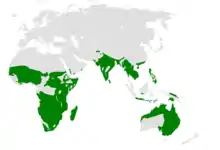 | |
| global range of genus[2] | |
| Synonyms | |
| |
Mirafra is a genus of lark in the family Alaudidae. Some Mirafra species are called "larks", while others are called "bush larks". They are found from Africa through South Asia to Australia.
Taxonomy
The genus Mirafra was introduced in 1821 by the American naturalist Thomas Horsfield to accommodate a single species, Mirafra javanica the singing bush lark, which is therefore considered as the type species.[3][4] The derivation of the genus name is unknown.[5]
The phylogeny of larks (Alaudidae) was reviewed by Alström et al. (2013) who found that the following species form a well supported monophyletic group, which is the sister lineage to Heteromirafra.[6]
Extant species
The genus contains twenty-four species:[7]
| Image | Scientific name | Common Name | Distribution |
|---|---|---|---|
%252C_crop.jpg.webp) | Mirafra fasciolata | Eastern clapper lark | southern Africa in Zambia, Namibia, Botswana, Lesotho and South Africa. |
 | Mirafra apiata | Cape clapper lark | southern Africa |
 | Mirafra hypermetra | Red-winged lark | Ethiopia, Kenya, Somalia, South Sudan, Tanzania and Uganda |
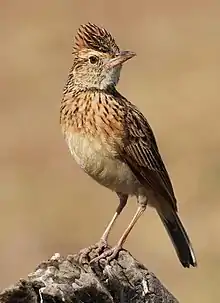 | Mirafra africana | Rufous-naped lark | sub-Saharan Africa |
| Mirafra sharpii | Sharpe's lark | northwestern Somalia | |
%252C_crop.jpg.webp) | Mirafra rufocinnamomea | Flappet lark | Central Africa |
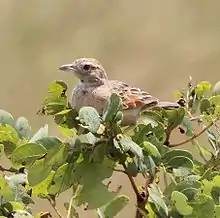 | Mirafra angolensis | Angola lark | southern and central Africa |
| Mirafra williamsi | Williams's lark | northern Kenya | |
.jpg.webp) | Mirafra passerina | Monotonous lark | southern Africa. |
 | Mirafra cheniana | Melodious lark | South Africa (Eastern Cape, the Free State, Gauteng, KwaZulu-Natal, Limpopo, and North West Province), Botswana and Zimbabwe |
_(12100175043)_(cropped).jpg.webp) | Mirafra javanica | Singing bush lark | Australia and much of Southeast Asia. |
.jpg.webp) | Mirafra microptera | Burmese bush lark | central Myanmar |
_in_Kolkata_W_IMG_4596.jpg.webp) | Mirafra assamica | Bengal bush lark | Bangladesh, Bhutan, India, Myanmar and Nepal |
_(cropped).jpg.webp) | Mirafra erythrocephala | Indochinese bush lark | southeast Asia. |
 | Mirafra erythroptera | Indian bush lark | Pakistan and northwestern, central and south-central India. |
.jpg.webp) | Mirafra affinis | Jerdon's bush lark | southeast India and Sri Lanka |
 | Mirafra gilletti | Gillett's lark | Ethiopia, Kenya, and Somalia |
| Mirafra rufa | Rusty bush lark | Sahel region of north-central Africa. | |
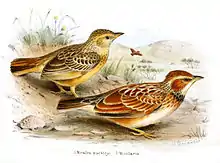 | Mirafra collaris | Collared lark | eastern Ethiopia and Somalia to central Kenya |
| Mirafra ashi | Ash's lark | Somalia. | |
.jpg.webp) | Mirafra somalica | Somali lark | Somalia |
| Mirafra pulpa | Friedmann's lark | East Africa. | |
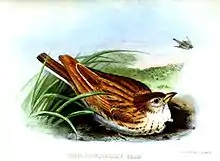 | Mirafra cordofanica | Kordofan lark | Mauritania and Senegal to Niger, eastern Chad, southern Sudan and northern South Sudan |
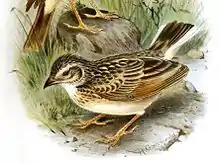 | Mirafra albicauda | White-tailed lark | western Chad, eastern Sudan, northeastern South Sudan, south-central Ethiopia, and from Uganda and western Kenya to central Tanzania |
Former species
Some authorities, either presently or formerly, recognize several additional species as belonging to the genus Mirafra, including:
- Short-clawed lark (as Mirafra chuana)[8]
- Dusky lark (as Mirafra nigricans)[9]
- Rufous-rumped lark (as Mirafra erythropygia or Mirafra nigricans erythropygia)[10]
- Indian desert finch-lark (as Mirafra phoenicuroides)[11]
- Rufous-tailed lark (as Mirafra phoenicura)[12]
- Madagascan lark (as Mirafra hova)[13]
- Sabota lark (as Mirafra sabota)[14]
- Bradfield's lark (as Mirafra naevia)[15]
- Pink-breasted lark (as Mirafra poecilosterna)[16]
- Foxy lark (as Mirafra alopex)[17]
- Masai fawn-coloured lark (as Mirafra intercedens)[18]
- Fawn-coloured lark (as Mirafra africanoides)[19]
- Karoo lark (as Mirafra albescens or Mirafra nivosa)[20]
- Red lark (as Mirafra burra)[21]
- Dune lark (as Mirafra erythrochlamys)[22]
- Barlow's lark (as Mirafra erythrochlamys barlowi)[23]
- Rudd's lark (as Mirafra ruddi)[24]
- Archer's lark (as Mirafra archeri)[25]
- Sidamo lark (as Mirafra sidamoensis)[26]
- Ngaundere sun lark (as Mirafra strümpelli)[27]
- Uele sun lark (as Mirafra bucolica)[28]
References
- ↑ "Alaudidae". aviansystematics.org. The Trust for Avian Systematics. Retrieved 2023-07-16.
- ↑ Based on maps in the Handbook of the Birds of the World and the BirdLife Datazone
- ↑ Horsfield, Thomas (1821). "Systematic arrangement and description of birds from the island of Java". Transactions of the Linnean Society. 13 (1): 133–200 [159].
- ↑ Mayr, Ernst; Greenway, James C. Jr, eds. (1960). Check-List of Birds of the World. Vol. 9. Cambridge, Massachusetts: Museum of Comparative Zoology. p. 3.
- ↑ Jobling, James A. (2010). The Helm Dictionary of Scientific Bird Names. London: Christopher Helm. p. 256. ISBN 978-1-4081-2501-4.
- ↑ Alström, Per; Barnes, Keith N.; Olsson, Urban; Barker, F. Keith; Bloomer, Paulette; Khan, Aleem Ahmed; Qureshi, Masood Ahmed; Guillaumet, Alban; Crochet, Pierre-Andre; Ryan, Peter G. (2013). "Multilocus phylogeny of the avian family Alaudidae (larks) reveals complex morphological evolution, non-monophyletic genera and hidden species diversity" (PDF). Molecular Phylogenetics and Evolution. 69 (3): 1043–1056. doi:10.1016/j.ympev.2013.06.005. PMID 23792153.
- ↑ Gill, Frank; Donsker, David, eds. (2018). "Nicators, reedling, larks". World Bird List Version 8.2. International Ornithologists' Union. Retrieved 15 July 2018.
- ↑ "Certhilauda chuana - Avibase". avibase.bsc-eoc.org. Retrieved 2016-11-11.
- ↑ "Pinarocorys nigricans - Avibase". avibase.bsc-eoc.org. Retrieved 2016-11-11.
- ↑ "Pinarocorys erythropygia - Avibase". avibase.bsc-eoc.org. Retrieved 2016-11-11.
- ↑ "Ammomanes deserti phoenicuroides - Avibase". avibase.bsc-eoc.org. Retrieved 2016-12-16.
- ↑ "Ammomanes phoenicura - Avibase". avibase.bsc-eoc.org. Retrieved 2016-12-17.
- ↑ "Eremopterix hova - Avibase". avibase.bsc-eoc.org. Retrieved 2016-11-14.
- ↑ "Calendulauda sabota - Avibase". avibase.bsc-eoc.org. Retrieved 2016-11-17.
- ↑ "Calendulauda naevia - Avibase". avibase.bsc-eoc.org. Retrieved 2016-11-17.
- ↑ "Calendulauda poecilosterna - Avibase". avibase.bsc-eoc.org. Retrieved 2016-11-17.
- ↑ "Calendulauda alopex - Avibase". avibase.bsc-eoc.org. Retrieved 2016-11-17.
- ↑ "Calendulauda intercedens - Avibase". avibase.bsc-eoc.org. Retrieved 2016-11-17.
- ↑ "Calendulauda africanoides - Avibase". avibase.bsc-eoc.org. Retrieved 2016-11-17.
- ↑ "Calendulauda albescens - Avibase". avibase.bsc-eoc.org. Retrieved 2016-11-18.
- ↑ "Calendulauda burra - Avibase". avibase.bsc-eoc.org. Retrieved 2016-11-19.
- ↑ "Calendulauda erythrochlamys - Avibase". avibase.bsc-eoc.org. Retrieved 2016-11-19.
- ↑ "Calendulauda barlowi - Avibase". avibase.bsc-eoc.org. Retrieved 2016-11-19.
- ↑ "Heteromirafra ruddi - Avibase". avibase.bsc-eoc.org. Retrieved 2016-11-21.
- ↑ "Heteromirafra archeri - Avibase". avibase.bsc-eoc.org. Retrieved 2016-11-21.
- ↑ "Heteromirafra sidamoensis - Avibase". avibase.bsc-eoc.org. Retrieved 2016-11-21.
- ↑ "Galerida modesta struempelli - Avibase". avibase.bsc-eoc.org. Retrieved 2016-12-06.
- ↑ "Galerida modesta bucolica - Avibase". avibase.bsc-eoc.org. Retrieved 2016-12-06.